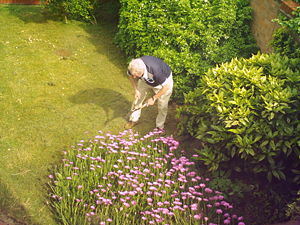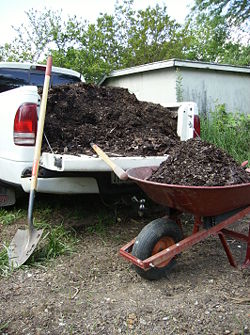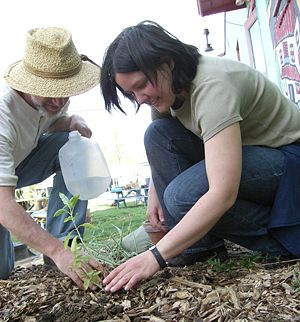Gardening
2008/9 Schools Wikipedia Selection. Related subjects: Recreation
Gardening is the practice of growing plants for their attractive flowers or foliage, and vegetables or fruits for consumption. Gardening is a human activity used to produce edible foods and use plants to beautify their local environmental conditions. Its scale ranges: from fruit orchards, to long boulevards plantings with one or more different types of shrubs, trees and herbaceous plants, to residential yards including lawns and foundation plantings, to large or small containers grown inside or outside. Gardening may often be very specific, with only one type of plant grown, or involve a large number of different plants in mixed plantings. It involves an active participation in the growing of plants and tends to be labor intensive, which differentiates it from farming or forestry.
History
Gardening for food extends far back into prehistory. Ornamental gardens were known in ancient times, a famous example being the Hanging Gardens of Babylon, while ancient Rome had dozens of gardens.
Types of gardening
Residential gardening takes place near the home, in a space referred to as the garden. Although a garden typically is located on the land near a residence, it may also be located on a roof, in an atrium, on a balcony, in a windowbox, or on a patio or vivarium.
Gardening also takes place in non-residential green areas, such as parks, public or semi-public gardens ( botanical gardens or zoological gardens), amusement and theme parks, along transportation corridors, and around tourist attractions and garden hotels. In these situations, a staff of gardeners or groundskeepers maintains the gardens.
Impact Gardening is a way of using small space to great effect, keeping plants close together, which blocks weeds and requires very little upkeep once started.
Indoor gardening is concerned with the growing of houseplants within a residence or building, in a conservatory, or in a greenhouse. Indoor gardens are sometimes incorporated as part of air conditioning or heating systems.
Water gardening is concerned with growing plants adapted to pools and ponds. Bog gardens are also considered a type of water garden. These all require special conditions and considerations. A simple water garden may consist solely of a tub containing the water and plant(s).
Container gardening is concerned with growing plants in any type of container either indoors or outdoors. Common containers are pots, hanging baskets, and planters. Container gardening is usually used in atriums and on balconies, patios, and roof tops.
Community gardening is a social activity in which an area of land is gardened by a group of people, providing access to fresh produce and plants as well as access to satisfying labor, neighbourhood improvement, sense of community and connection to the environment. Community gardens are typically owned in trust by local governments or nonprofits.
Gardeners
A "gardener" is any person involved in gardening, arguably the oldest occupation, from the hobbyist in a residential garden, the homeowner supplementing the family food with a small vegetable garden or orchard, to an employee in a nursery or the head gardener in a large estate.
The term gardener is also used to describe garden designers and landscape gardeners, who are involved chiefly in the design of gardens, rather than the practical aspects of horticulture.
Gardening has a long history, and there have been many pioneering gardeners of note, from the great landscape gardeners of the 18th century, to those who created or expanded the idea of the "no-dig" garden. In addition, television lifestyle programs have spawned a number of celebrity gardeners.
Comparison with farming
In respect to its food producing purpose, gardening is distinguished from farming chiefly by scale and intent. Farming occurs on a larger scale, and with the production of saleable goods as a major motivation. Gardening is done on a smaller scale, primarily for pleasure and to produce goods for the gardener's own family or community. There is some overlap between the terms, particularly in that some moderate-sized vegetable growing concerns, often called market gardening, can fit in either category.
The key distinction between gardening and farming is essentially one of scale; gardening can be a hobby or an income supplement, but farming is generally understood as a full-time or commercial activity, usually involving more land and quite different practices. One distinction is that gardening is labor-intensive and employs very little infrastructural capital, typically no more than a few tools, e.g. a spade, hoe, basket and watering can. By contrast, larger-scale farming often involves irrigation systems, chemical fertilizers and harvesters or at least ladders, e.g. to reach up into fruit trees. However, this distinction is becoming blurred with the increasing use of power tools in even small gardens.
In part because of labor intensity and aesthetic motivations, gardening is very often much more productive per unit of land than farming. In the Soviet Union, half the food supply came from small peasants' garden plots on the huge government-run collective farms, although they were tiny patches of land. Some argue this as evidence of superiority of capitalism, since the peasants were generally able to sell their produce. Others consider it to be evidence of a tragedy of the commons, since the large collective plots were often neglected, or fertilizers or water redirected to the private gardens.
The term precision agriculture is sometimes used to describe gardening using intermediate technology (more than tools, less than harvesters), especially of organic varieties. Gardening is effectively scaled up to feed entire villages of over 100 people from specialized plots. A variant is the community garden which offers plots to urban dwellers; see further in allotment (gardening).
Gardens as art
Garden design is considered to be an art in most cultures, distinguished from gardening, which generally means garden maintenance. In Japan, Samurai and Zen monks were often required to build decorative gardens or practice related skills like flower arrangement known as ikebana. In 18th century Europe, country estates were refashioned by landscape gardeners into formal gardens or landscaped park lands, such as at Versailles, France or Stowe, England. Today, landscape architects and garden designers continue to produce artistically creative designs for private garden spaces.
Social aspects
In modern Europe and North America, people often express their political or social views in gardens, intentionally or not. The lawn vs. garden issue is played out in urban planning as the debate over the " land ethic" that is to determine urban land use and whether hyper hygienist bylaws (e.g. weed control) should apply, or whether land should generally be allowed to exist in its natural wild state. In a famous Canadian Charter of Rights case, "Sandra Bell vs. City of Toronto", 1997, the right to cultivate all native species, even most varieties deemed noxious or allergenic, was upheld as part of the right of free expression.
People often surround their house and garden with a hedge. Common hedge plants are privet, hawthorn, beech, yew, leyland cypress, hemlock, arborvitae, barberry, box, holly, oleander, forsythia and lavender. The idea of open gardens without hedges may be distasteful to those who enjoy privacy. This may have an advantage to local wildlife by providing a habitat for birds, animals, and wild plants.
Gardening is thus not only a food source and art, but also a right. The Slow Food movement has sought in some countries to add an edible school yard and garden classrooms to schools, e.g. in Fergus, Ontario, where these were added to a public school to augment the kitchen classroom.
In US and British usage, the production of ornamental plantings around buildings is called landscaping, landscape maintenance or grounds keeping, while international usage uses the term gardening for these same activities.
Garden pests
- A garden pest is what one considers a pest. The beautiful Tropaeolum speciosum can be considered a pest if it seeds and starts to grow where it is not wanted. As the root is well below ground, pulling it up does not remove it: it simply grows again and becomes what may be considered a pest.
- In lawns, moss can become dominant and be impossible to eradicate. In some lawns, lichens, especially very damp lawn lichens such as Peltigera lactucfolia and P. membranacea, can become difficult and be considered pests.
- Other garden pests include insects. There are several ways to remove unwanted pests from a garden.
Restrictions
Governments of most countries are restricting imports of plant material. In the past, someone could send such things as lily seeds and bulbs to friends in any country. Today, most of those avenues are closed, due to the threat of invasive species.
Further watching
- ANOTHER WORLD IS PLANTABLE!- FILMS on Community Gardens world wide


